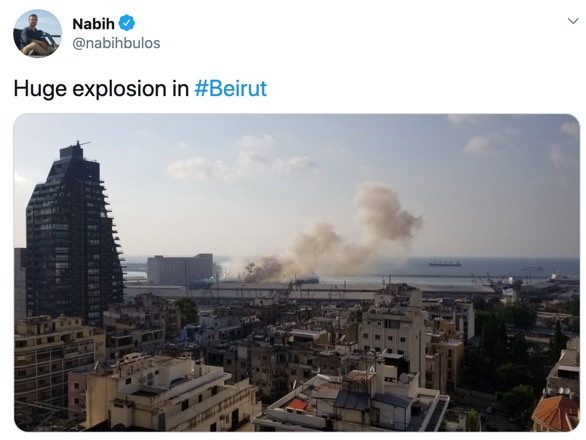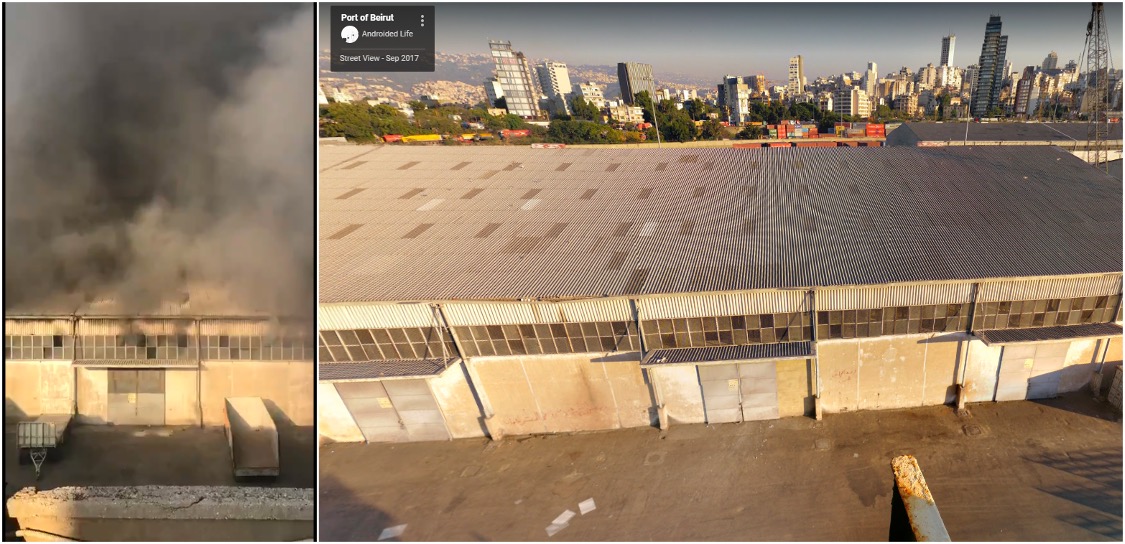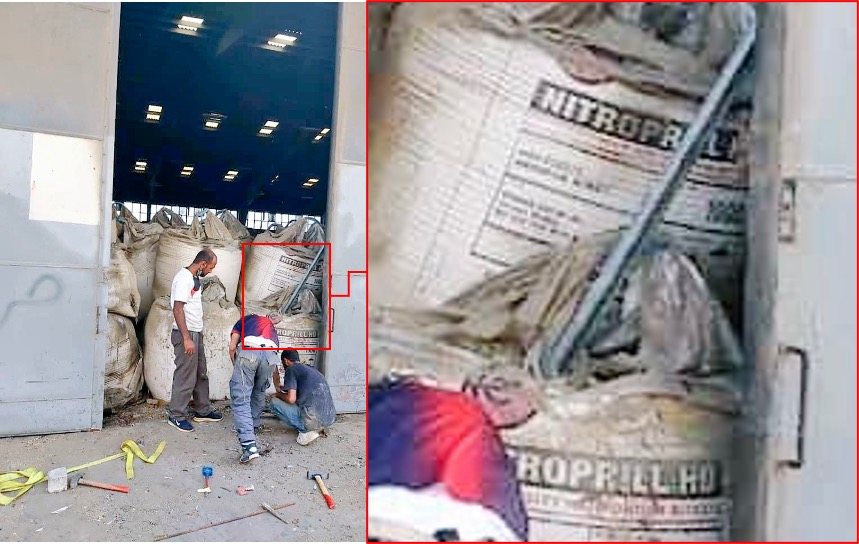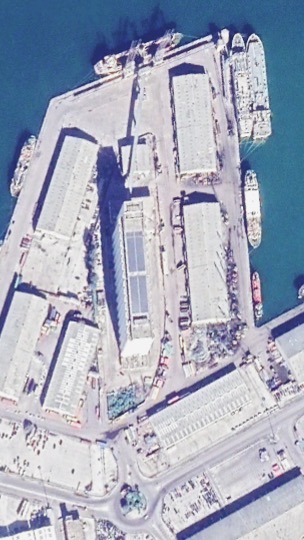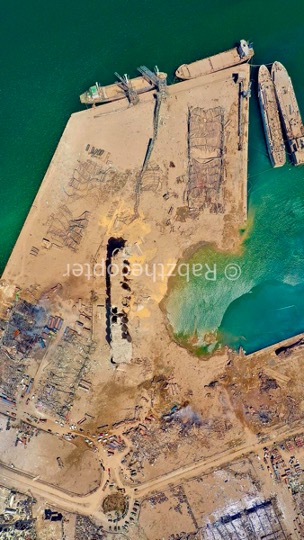What Just Blew Up In Beirut?
Shortly before 6 PM Beirut time reports began flooding Twitter of a fire and a series of explosions in Beirut. It rapidly became evident that event was far more than a small industrial fire.
Shortly after, videos and images of a vast explosion flooded onto social media. The video below is a clear example, showing a fire, suddenly transforming into a vast fireball and a shockwave which ripped buildings apart.
Where did the explosion happen?
The videos and images of this event all focus on a single location on the docks in Beirut at 33.901353, 35.518835. Although there were claims of explosions at other locations, there does not appear to be images or videos of this, and it is likely these reports were simply a result of the vast explosion at the docks.
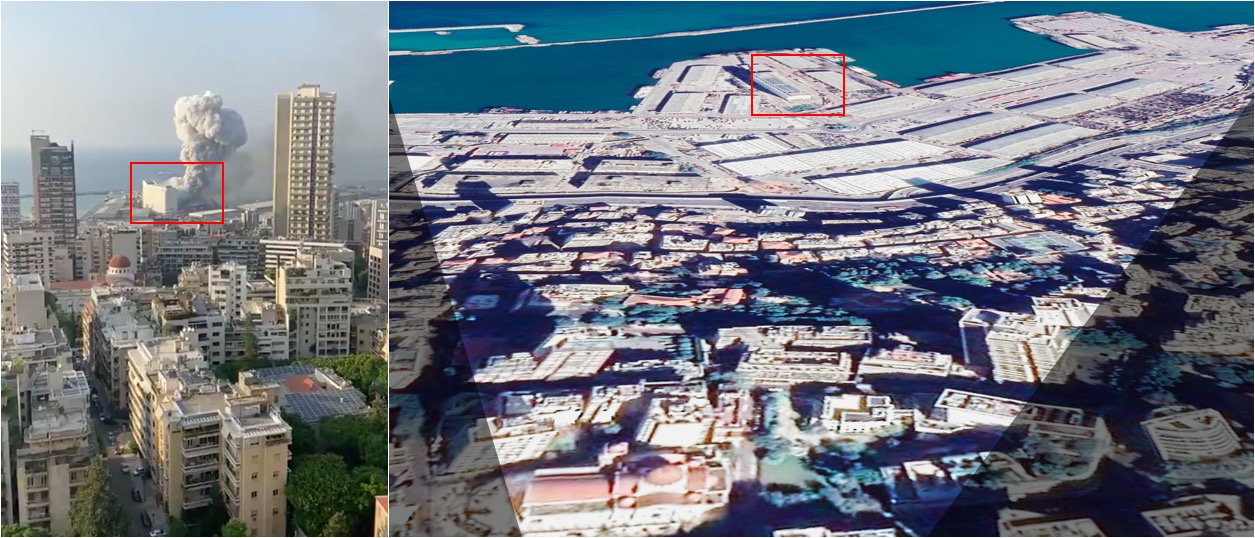
Left: video of smaller explosion, Right: Satellite imagery of smaller explosion location (credit: Google/CNES/Airbus)
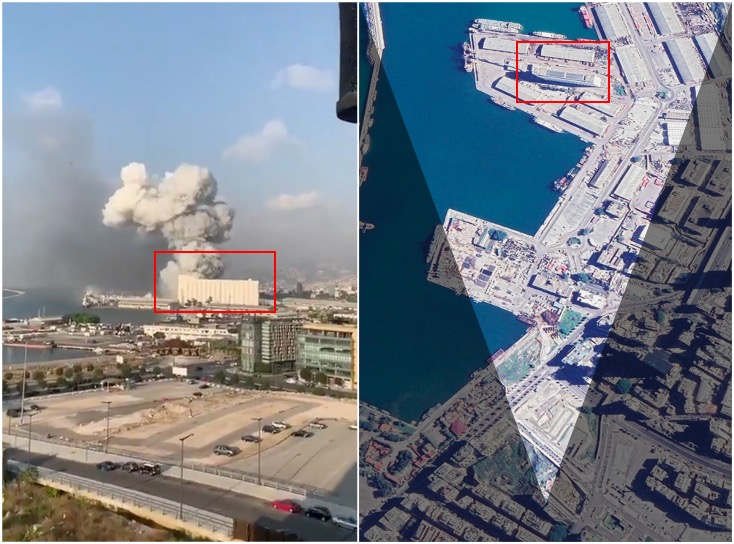
Left: video of smaller explosion, Right: Satellite imagery of smaller explosion location (credit: Google/CNES/Airbus)
What happened?
Although there were some claims that this explosion could have been a ship, or indeed an airstrike, nothing in open source videos suggest this was the case. Multiple images and videos show a warehouse on fire and several smaller explosions shortly before a gigantic detonation. The video below captures this in detail.
In the video above, the epicenter of the blast appears to be a warehouse on the dock located at 33.901353, 35.519006. Some users on social media have referred to this as “warehouse 12“. Note that the Beirut Port Silos to the west (left) do not appear to be the initial source of this detonation.
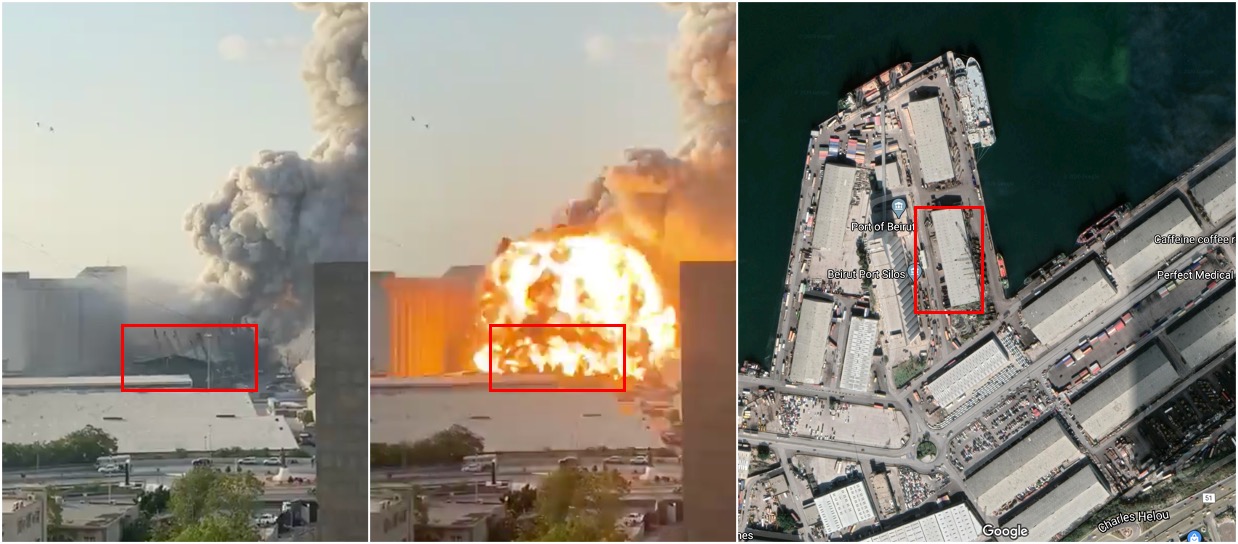
Video source
This appears to be supported by a video filmed from the the roof of the Beirut Port Silos which show this warehouse on fire, shortly followed by an explosion. Due to the size of the explosion seen on the video below, it seems unlikely this was the largest explosion, but rather some of the smaller initial detonations.
We can confirm this general location by comparing the warehouse seen in the video to images of a warehouses tagged to this location on Google Maps.
We can also see a distinctive wire or tube running down onto the building on which the person who is filming is standing. Using this we can place their exact location as 33.901750, 35.518238, about 40 meters away from the warehouse. This also confirms that they are filming the north side of the warehouse at 33.901353, 35.519006, which appears to be on fire.
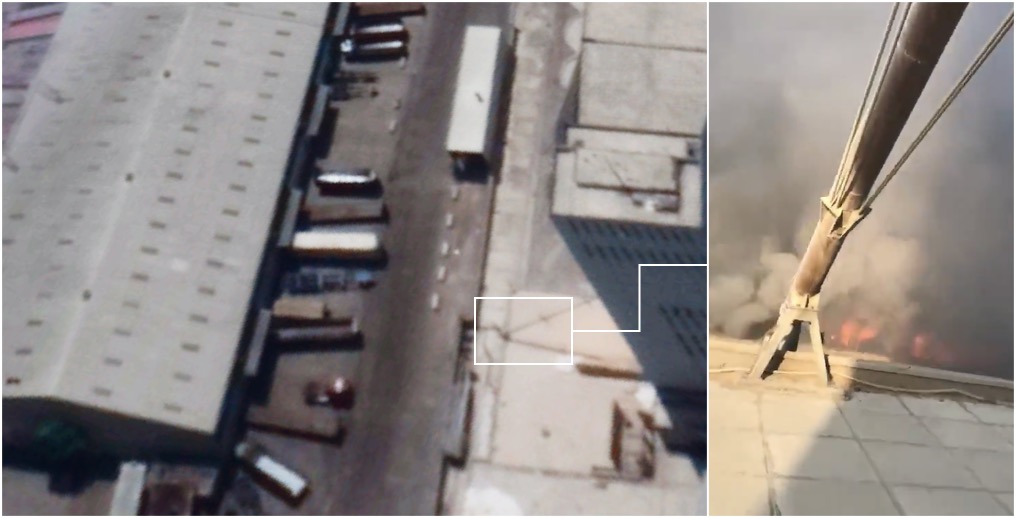
Left: satellite imagery (credit: Google/Maxar Technologies) Right: still from video
Due to the power of the large explosion, which we will expand upon below, we do not believe this video shows the largest detonation. Instead, it is more likely to show one of the earlier, smaller detonations. After the largest explosion, the building on which the person was standing appears to have been destroyed.
What caused the explosion?
There has been some speculation about the cause of this blast. Notable features of this explosion include a reddish cloud and a large number of small flashes visible in the fire before the large explosion. Some local media accounts posted claims that explosive material had been improperly stored at this location, however those Tweets were later deleted.
Others pointed to a 2,750 ton shipment of ammonium nitrate that had been sitting at the Port since at least late 2013. Al Jazeera reported that, despite repeated requests for guidance by the customs authority, no decision were made regarding what to do with this shipment. Instead, it simply remained in a warehouse at the port. This matched statements from the Lebanese President Michel Aoun, who blamed a shipment of 2,700 tons of ammonium nitrate which had been sitting at the port for six years.
Ammonium nitrate is the primary ingredient in various explosives, the most well known of which is ANFO. Timothy McVeigh used an ammonium nitrate based explosive in the Oklahoma City bombing. It was noted that 2,750 tons of this chemical would likely result in an explosion equivalent to several hundred tons of TNT, which is consistent with initial estimates of the size of the blast.
A photo posted by several accounts claimed to show this shipment in a warehouse at Beirut’s port, apparently stored in large sacks piled on top of each other. The image shows large sacks labelled “NITROPRILL”. NITROPRIL (with one L) is the trade name of a form of Ammonium Nitrate produced by Orica. Due to the slight difference in the spelling of the name, it is possible that the sacks seen in the photo are a knock off version. The only reference we could find to a product spelled this way was a Brazilian company called Nitro Prill Bombeamento de Explosivos.
It was possible to match features from this photo to features of the warehouses at the docks. The design of the windows, the skylights and the doors markings of the warehouse appear to match those of warehouses at the port of Beirut, indicating that this photo was likely taken there, although it was not possible to confirm exactly which warehouse this photo depicts.

Left: image claimed to show Ammonium Nitrate shipment at port of Beirut. Right: satellite image (courtesy of Google/Maxar Technologies) and still from video of fire

Left: image claimed to show Ammonium Nitrate shipment at port of Beirut. Right: still from video of fire
Despite some claims to the contrary, we can definitively say that it was not a nuclear detonation.
What damage was done?
This explosion was clearly gigantic. There are significant amounts of images and videos showing huge amounts of Beirut have sustained severe damage. The video below, a slowed version of one of those taken on the ground, clearly shows parts of buildings disintegrating as the shockwave hits them.
Indeed, this shockwave appears to have reached Cyprus. Various social media accounts posted about this, and we received at least one report that the shockwave had shaken windows there. Interestingly, seismic monitoring data at various locations identified a blip at this time, and a 3.5 magnitude earthquake was registered in Beirut.
Jeffery Lewis, a nuclear weapons expert, concurred with preliminary and rough calculations that this explosion could have been equivalent to ~240 tons of TNT. Needless to say, he emphasised that this is a very rough calculation.
However large it was, this explosion has devastated swathes of Beirut. As well as structural damage near to the epicenter, the shockwave shattered windows and smashed down doors kilometres away.
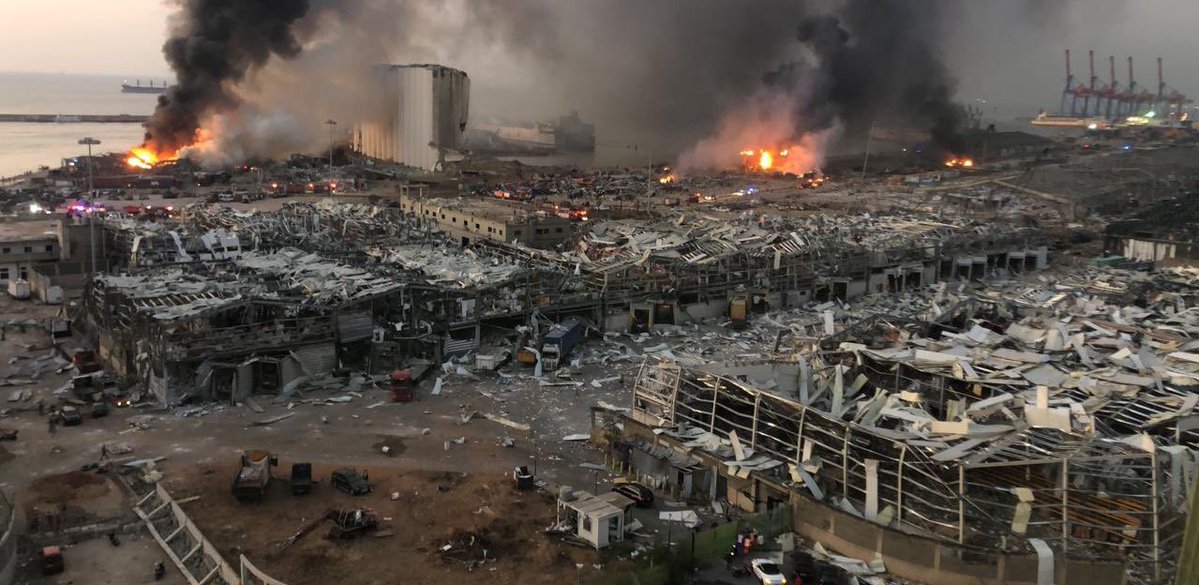
View of the docks from the south west
Due to the fire and smaller explosions, many people in Beirut would have been standing by windows recording the scene. As the blast hit, many of these people would have been hit by flying glass, including their own shattered windows. It is therefore unsurprising that hospitals appear to be overwhelmed by the number of casualties this blast has caused. At the time of writing initial casualty estimates indicated 50 dead and several thousand wounded.
Images from the next day show that the port has been utterly devastated. The location of the warehouse is now simply a vast crater, approximately 150 meters wide, filled with water.
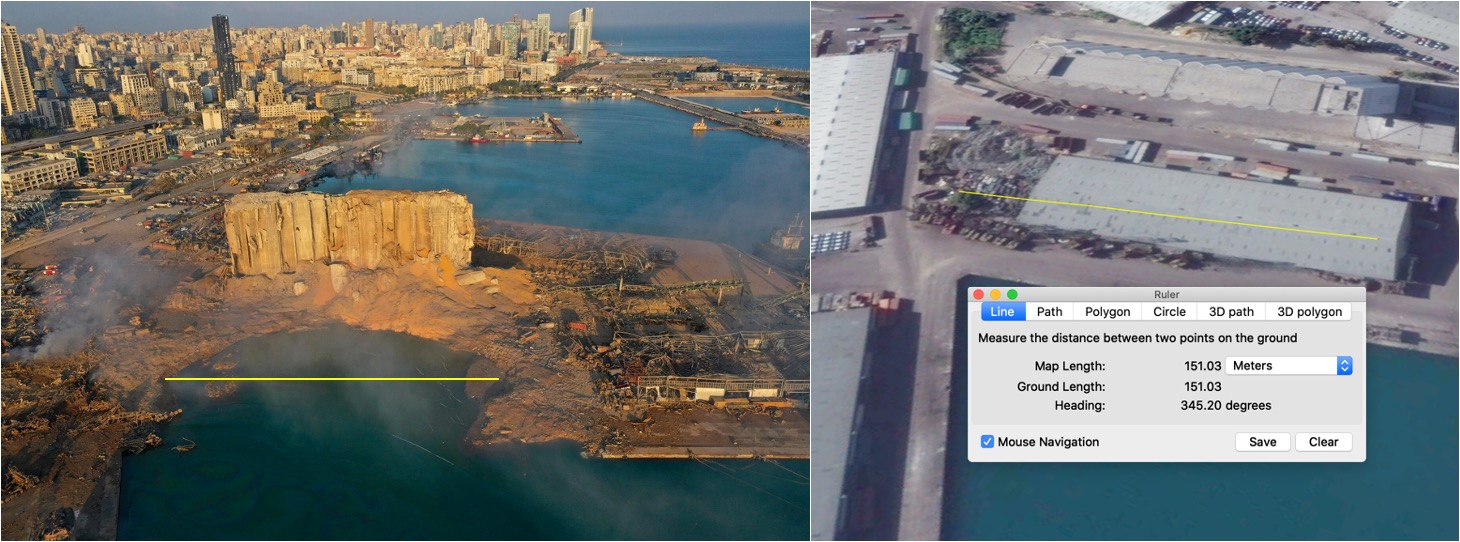
Left: drone image showing crater, Right: measurement of crater (courtesy of Google/Maxar)
Conclusion
From the available information it is clear that shortly before 6 PM in Beirut a fire and series of explosions at the docks in Beirut set off a gigantic explosion, the effects of which were felt as far away as Cyprus. Damage is widespread around the city and thousands are reported to have been wounded. The epicenter of the blast appears to have been the warehouse at 33.901353, 35.518835, and while the official explanation has yet to be confirmed, multiple sources on information point towards a shipment of 2,700 tons of ammonium nitrate that had been sitting in the port since 2013.
This explosion is one more layer of misery on a country suffering under severe economic conditions, inflation and frequent power-cuts. No doubt there will now be a large amount of interest about exactly what was stored in that warehouse, and why something so dangerous was being stored so close to the center of such a bustling city.
